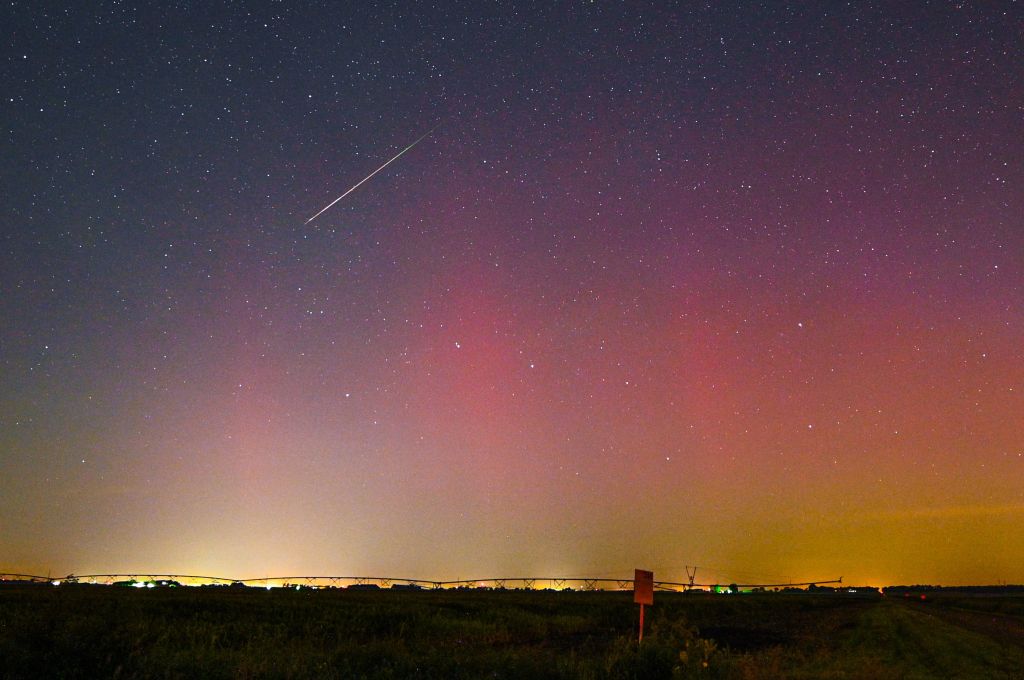Get ready to wish upon several shooting stars.
In its annual summertime display, up to 100 Perseids meteors will streak skies with color and lights across the Northern Hemisphere as the shower peaks from Sunday night to Monday morning, best seen after midnight.
NASA scientists say viewing might be affected earlier in the evening by the bright glare of the moon, but it will set right as the meteor showers peak. They suggest avoiding city lights and finding clear skies to make the most of the experience.
Viewers in the right place at the right time might be able to see one meteor per minute. They can go as fast as 37 miles per second. Experts say it can be a remarkable and even overwhelming experience.
The Perseids are named after the Perseus constellation from which they appear to radiate, according to the Adler Planetarium in Chicago. The Adler explains that, while meteors are colloquially recognized as shooting stars, they are not caused by stars but rather rocks and metal bits from comets burning in Earth’s atmosphere when the planet runs into a trail of debris.
This meteor shower is known for being plentiful and is part of the debris stream of the periodical comet Swift-Tuttle. It can be observed annually from mid- to late July and through August as the asteroid comes around the sun. Sometimes it can produce fireball explosions of light and color.
Landon Moeller, 19, a Schaumburg native and junior meteorology major at Northern Illinois University, drove out toward the village of Walnut on Saturday night to try to see some meteors.
“I saw the sky flash this bright teal blue,” he said. “So there’s always a chance for something special like that. But even just the regular meteors are amazing as well.”
Seen from Earth every year for centuries, the Perseids are still a spectacle. Viewers might see five meteors within a few seconds and then go several minutes without seeing any, but the wait is part of the thrill.
How to watch
After midnight: Experts suggest viewing during predawn hours and allowing the eyes to adjust for about half an hour, then looking across the sky with a special focus on the northeast to find streaks of light.
No equipment is necessary, as meteor showers are best seen with the naked eye in clear skies with little surrounding light.
For Chicagoans who can’t leave the city, heading toward the lakefront and looking beyond the horizon might offer a relatively dark view.
Find darkness: Those who can drive to avoid pollution from city lights might want to head east of Aurora and Elgin, south of Joliet and north of Waukegan to avoid the brightest lights. Maps like lightpollutionmap.info can indicate the best viewing locations.
In Illinois, the International Dark Sky Association also recommends heading to these communities and parks for dark skies and prime viewing: the village of Hawthorn Woods, Homer Glen, the Middle Fork River Forest Preserve near Urbana-Champaign and Mount Forest Island in the Palos Preserves.
Look for clear skies: The main thing preventing hopeful viewers from catching a glimpse of the meteor shower could be clouds. Between midnight and 3 a.m., 20% to 35% of skies above the Chicago area will have clouds, according to a National Weather Service forecast.
Zachary Yack, a meteorologist with the National Weather Service’s Chicago office, said clouds will roll in from the west as early as 10 p.m., but the cover will be high up in the atmosphere and thin.
“You should still be able to see through it decently,” Yack added. “So thicker clouds are gonna probably block out your viewing of any meteor showers, or even any of the stars.”
Those thicker clouds will reach the Chicago metro area around 3 to 4 a.m. At about 4 a.m., the night sky and stars will begin to fade from view as dawn approaches at 5:25 a.m. and the sun rises over the city at 5:56 a.m.
More sky-watching treats
Lucky people in northern states like the Dakotas, Wisconsin, Michigan, Montana and Washington might get a double treat on Sunday night and early Monday. This is because the sun has been expelling plasma in recent days, which can disrupt the Earth’s magnetic fields and cause powerful Aurora Borealis displays.
A few hours into his sky-gazing, Moeller said he captured a photo of a meteor shooting across a sky painted with the Northern Lights — a combination he had seen twice before.
“I feel like it never will get old,” he said.
The next big, reliable meteor shower, known as the Geminids, will peak in December.
